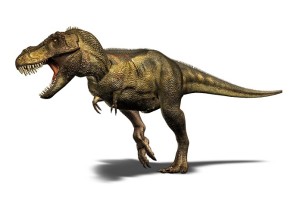Updated on: 29/03/2022
Tyrannosaurus Rex, popularly known as T-rex, is an extinct species of coelurosaurian theropod dinosaur that lived around 68 to 66 million years ago. It is believed that they were the last non-avian dinosaurs to exist before Cretaceous–Paleogene extinction event. T-rex, the type species of genus Tyrannosaurus, is one of the most well-represented theropods till now.
| Kingdom: | Animalia |
| Phylum: | Chordata |
| Clade: | Dinosauria |
| Order: | Saurischia |
| Suborder: | Theropoda |
| Family: | Tyrannosauridae |
| Subfamily: | Tyrannosaurinae |
| Tribe: | Tyrannosaurini |
| Genus: | Tyrannosaurus |
| Species: | Tyrannosaurus rex (scientific name) |
| Pronunciation: | tye-RAN-uh-SAWR-us reks |
| Geological Time Period: | Maastrichtian age of the upper Cretaceous Era |
| Size: | Length – 40 feet (12.3 m) Height – 13 feet (4 m) at hips |
| Weight: | 14000 to 15000 lbs |
| Range/Location: | Western North America (previously Laramidia) |
| Diet: | Carnivore |
| Habitat/Environment: | Forested river valleys, coastal and inland subtropical and semi-arid plains. |
| Birth type: | Eggs |
| Running speed: | 42 to 70 kmph |
| Locomotion: | Bipedal |
Tyrannosaurus Rex had a massive skull that was around 5 ft in length. Its brain, almost cylindrical and long in shape, was small compared to its overall body mass. It had a 4-foot long jaw with conical, serrated teeth. They had a short, muscular S-shaped neck. Their arms, which were literally smaller compared to its overall built, had two clawed digits. They had large and powerful hind limbs. It had a long and heavy tail that contained around forty vertebrae. Scientists believe that some of their bones were hollow in order to balance its weight. There is no real evidence that T-rex possessed feathers. However, modern-day scientists believe that they probably had feathers in some parts of its body, at some stage of its age. It is suggested that feather covering depended on the size of the animal, climate, age and several other factors. Skin impressions from a specimen called Wyrex (BHI 6230I) found in Montana show little patches of mosaic scales.
As scientists recognized more specimens showing distinct body types, they came to the suggestion that it had sexual dimorphism. Researchers saw that the pelvis of several specimens was wider probably to allow room for eggs; and it also led to the suggestion that females were more robust than males. Some other accounts hints that different anatomical features can be an indication of geographical location or age.

Over fifty Tyrannosaurus rex specimens have been identified with some being almost complete. The first ever Tyrannosaurus rex sample was found by Arthur Lakes in 1874 near Golden, Colorado. In 1892, Edward Drinker Cope unearthed vertebral fragments in western South Dakota. The first partial skeleton was found in 1900 by American Museum of Natural History assistant curator Barnum Brown in eastern Wyoming. He also found another partial skeleton in 1902 in the Hell Creek Formation, Montana. H. F. Osborn used this sample to describe Tyrannosaurus rex. In 1990, amateur paleontologist Sue Hendrickson found the most complete specimen of Tyrannosaurus in the Hell Creek Formation near Faith, South Dakota. The sample was later named Sue. A study in 2011 revealed that the weight of the actual individual was somewhere between 9.5 to 18.5 metric tons (20943.9 to 40785.52 pounds). In the year 2000, Jack Horner found remains of five Tyrannosauruses near the Fort Peck Reservoir in Montana; and one of them was suggested to be largest specimen ever found.
University of Alberta’s Philip J. Currie suggested that T-rex lived in packs. But his hypothesis attracted a lot of criticism, and it is a subject that still needs to go through detailed scientific studies. They probably had a large range compared to other tyrannosaurids. A study by University of Oregon’s Kent Stevens showed that T-rex had a great eye sight. There has been a lot of debate regarding T-rex’s eating habits. Paleontologists believe that they were an apex predator in its habitat. They preyed upon ceratopsians (such as Triceratops), hadrosaurs and sauropods. While, some other experts believe that they were primarily scavengers. Modern-day paleontologists suggested that they were opportunistic carnivore – both scavenging and hunting. They are known to have a great bite force. They used their forelimbs while catching or dealing with their prey. Modern-day paleontologists believe that T-rex was endothermic (warm-blooded) given its active lifestyle. However, another account suggests that they were able to maintain a constant internal body temperature (known as homeothermy) balancing somewhere between endothermic mammals and ectothermic reptiles.
The word “Tyrannosaurus” comes from Ancient Greek word “tyrannos” meaning ‘tyrant’ and “sauros” meaning ‘lizard.’ In Latin, the meaning of “rex” is ‘king.’ T-rex was named in 1905 by American Museum of Natural History’s then-president Henry Fairfield Osborn.
There is no concrete evidence of their lifespan. Histologic analysis has been done on individual specimens. It showed that Sue was 28 years old when it died, and it may have been close to their actual life expectancy.